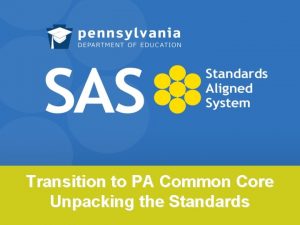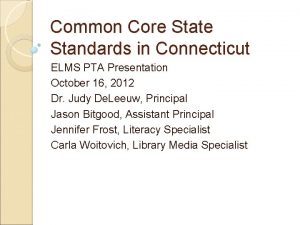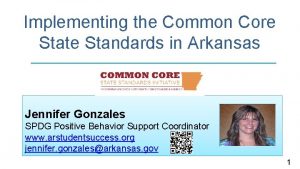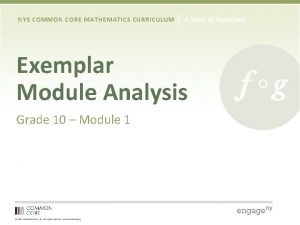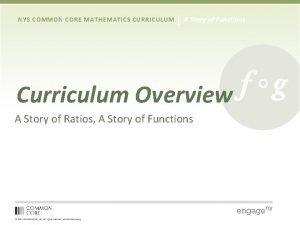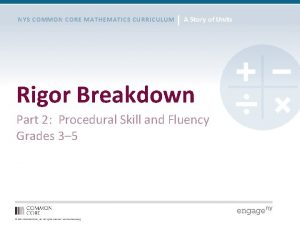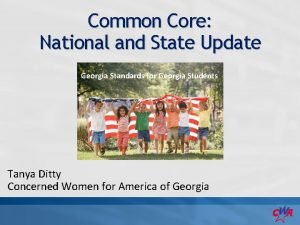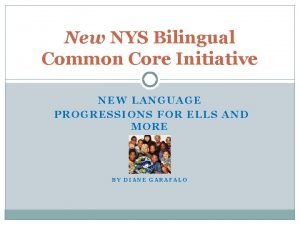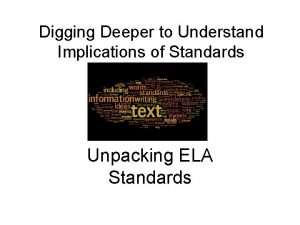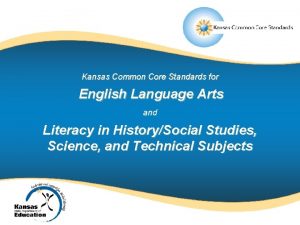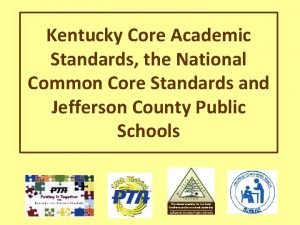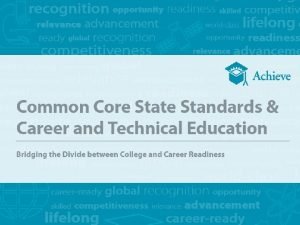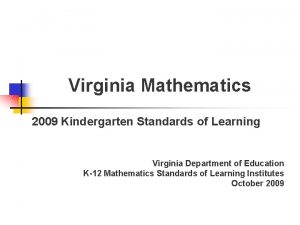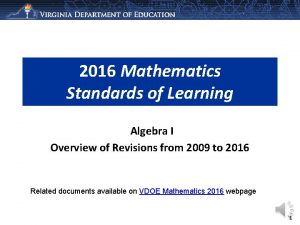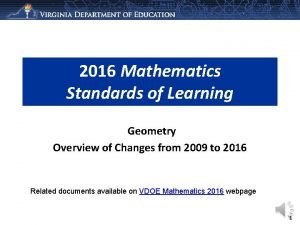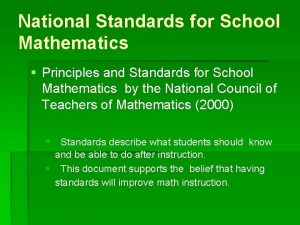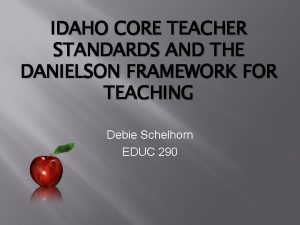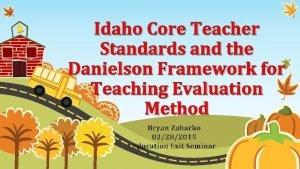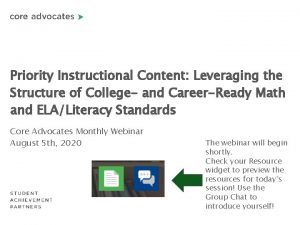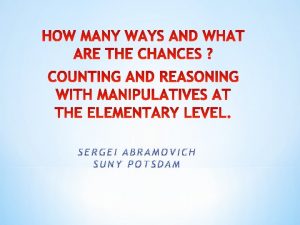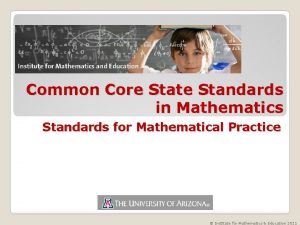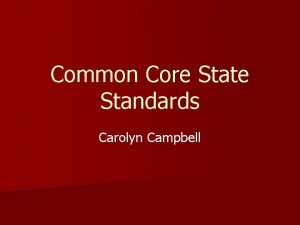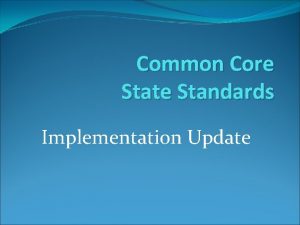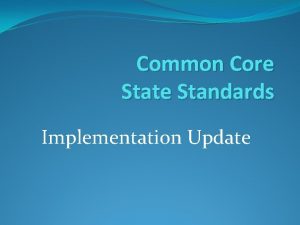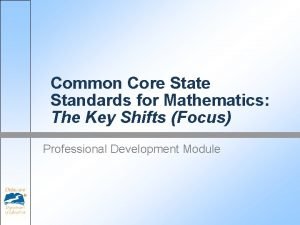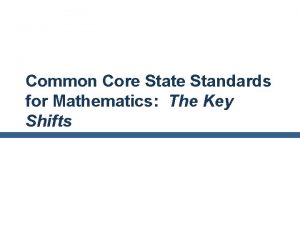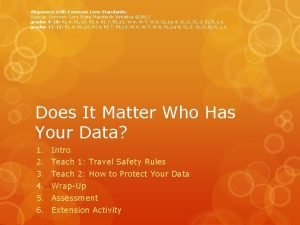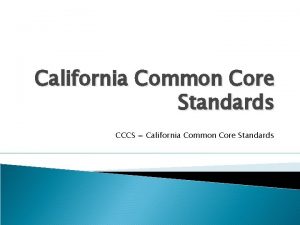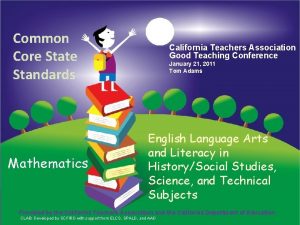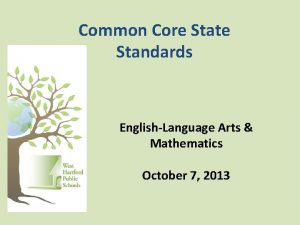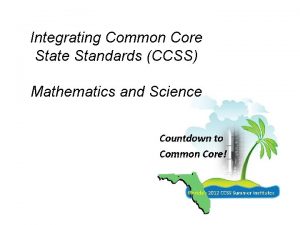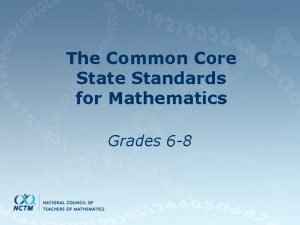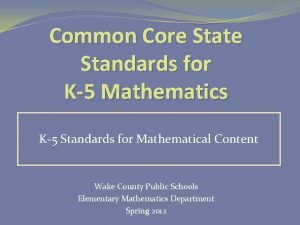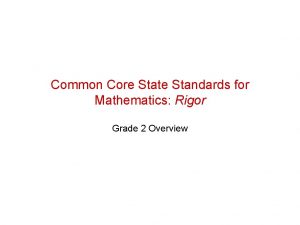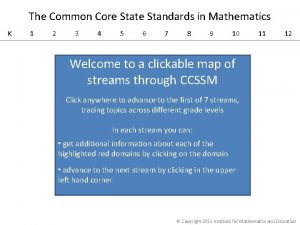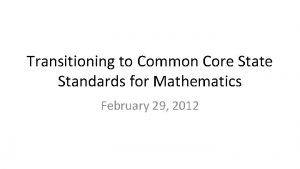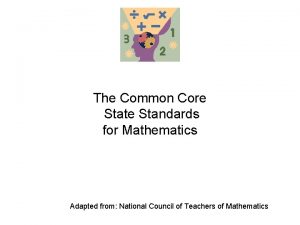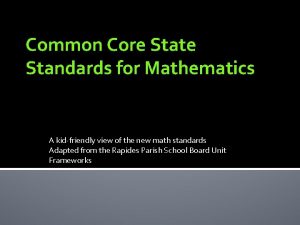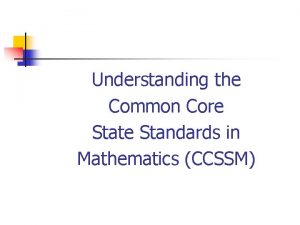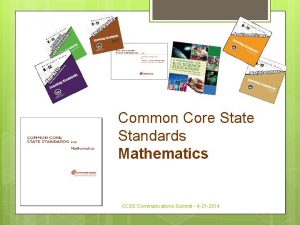Common Core State Standards for Mathematics The Key



























- Slides: 27

Common Core State Standards for Mathematics: The Key Shifts (Focus) Professional Development Module

2

The Background of the Common Core Initiated by the National Governors Association (NGA) and Council of Chief State School Officers (CCSSO) with the following design principles: • Result in College and Career Readiness • Based on solid research and practice evidence • Fewer, higher and clearer 3

College Math Professors Feel HS students Today are Not Prepared for College Math Ø 4

What The Disconnect Means for Students ØNationwide, many students in two-year and four-year colleges need remediation in math. ØRemedial classes lower the odds of finishing the degree or program. ØNeed to set the agenda in high school math to prepare more students for postsecondary education and training. 5

The CCSS Requires Three Shifts in Mathematics 1. Focus: Focus strongly where the standards focus. 2. Coherence: Think across grades, and link to major topics 3. Rigor: In major topics, pursue conceptual understanding, procedural skill and fluency, and application 6

Shift #1: Focus Strongly where the Standards Focus ØSignificantly narrow the scope of content and deepen how time and energy is spent in the math classroom. ØFocus deeply on what is emphasized in the standards, so that students gain strong foundations. 7

Focus • Move away from "mile wide, inch deep" curricula identified in TIMSS. ØLearn from international comparisons. ØTeach less, learn more. • “Less topic coverage can be associated with higher scores on those topics covered because students have more time to master the content that is taught. ” – Ginsburg et al. , 2005 8

The shape of math in A+ countries Mathematics topics intended at each grade by at least two-thirds of 21 U. S. states Mathematics topics intended at each grade by at least two-thirds of A+ countries 1 Schmidt, 9 Houang, & Cogan, “A Coherent Curriculum: The Case of Mathematics. ” (2002).

Traditional U. S. Approach K Number and Operations Measurement and Geometry Algebra and Functions Statistics and Probability 10 12

Focusing Attention Within Number and Operations and Algebraic Thinking Expressions → and Equations Number and Operations— Base Ten → K 1 2 3 4 Algebra The Number System Number and Operations— Fractions → → → 5 6 7 8 High School 11

12

Engaging with the shift: What do you think belongs in the major work of each concept or grade level? Grade Which two of the following represent areas of major focus for the indicated grade? 6 Understand ratio concepts and use Identify and utilize rules of ratio reasoning to solve problems divisibility Apply and extend previous understandings of arithmetic to algebraic expressions 7 Apply and extend previous understandings of operations with fractions to add, subtract, multiply, and divide rational numbers Use properties of operations to generate equivalent expressions Generate the prime factorization of numbers to solve problems 8 Standard form of a linear equation Define, evaluate, and compare functions Understand apply the Pythagorean Theorem Quadratic inequalities Linear and quadratic functions Creating equations to model situations Understand the congruence in terms of rigid motions Apply geometric concepts in modeling situations Solve systems of equations Exponential and logarithmic functions Polar coordinates Using functions to model situations Alg. 1 Geom. Alg. 2 13

High School Standards Ø High School Standards Conceptual Categories § § § Ø Number and Quantity Algebra Functions Modeling Geometry Statistics and Probability Find the conceptual category - Algebra. § (*) – Notice the * by Interpret expressions that represent a quantity in terms of its context Ø Find the conceptual category – Geometry § (+) – Notice the (+) by Derive the formula A=1/2 ab sin (C) for the area of a triangle by drawing an auxiliary line from a vertex perpendicular to the opposite side. 14

Mathematical Practices Ø Ø Ø Ø 1. Make sense of problems and persevere in solving them. 2. Reason abstractly and quantitatively. 3. Construct viable arguments and critique the reasoning of others. 4. Model with mathematics. 5. Use appropriate tools strategically. 6. Attend to precision. 7. Look for and make use of structure. 8. Look for and express regularity in repeated reasoning.

Appendix A It takes each of the Common Core Standards and shows in what year or course the standards should be taught, no matter which path your school takes. Ø Traditional: Algebra, Geometry, Algebra II, Fourth Course Ø Integrated: Math I-IV Ø This Appendix A is very helpful in making the shift to a CCS aligned curriculum. Ø http: //www. corestandards. org/assets/CCSSI_Mathematics_Appendix_A. pdf

Group Discussion Shift #1: Focus strongly where the Standards focus. Ø In your groups, discuss ways to respond to the following question, “Why focus? There’s so much math that students could be learning, why limit them to just a few things? ” 17

Fluency in High School 18

Application • Students can use appropriate concepts and procedures for application even when not prompted to do so. • Teachers provide opportunities at all grade levels for students to apply math concepts in “real world” situations, recognizing this means different things in K -5, 6 -8, and HS. • Teachers in content areas outside of math, particularly science, ensure that students are using grade-level-appropriate math to make meaning of and access science content. 19

The Coming CCSS Assessments Will Focus Strongly on the Major Work of Each Grade 20

Content Emphases by Cluster: Grade Four Key: Major Clusters; Supporting Clusters; Additional Clusters PARCC Model Content Frameworks for Mathematics Version 2 -Aug. 20, 21 2012

www. achievethecore. org 22

Cautions: Implementing the CCSS is. . . • • Not about “gap analysis” Not about buying a text series Not a march through the standards Not about breaking apart each standard 23

Resources Ø www. achievethecore. org Ø www. illustrativemathematics. org Ø www. pta. org/4446. htm Ø commoncoretools. me Ø www. corestandards. org Ø http: //parcconline. org/parcc-content-frameworks Ø http: //www. smarterbalanced. org/k-12 education/common-core-state-standards-toolsresources/ 24

Teacher Resources http: //www. doe. k 12. de. us/commoncore/ Ø http: //educationnorthwest. org/commoncore Ø http: //www. ccsso. org/Resources. html Ø www. corestandards. org Ø http: //www. centeroninstruction. org/ Ø www. learningpt. org/greatlakeseast/ Ø http: //www. youtube. com/playlist? list=PLD 7 F 4 C 7 DE 7 CB 3 D 2 E 6 Ø

http: //www. illustrativemathematics. org/ Ø http: //math. arizona. edu/~ime/progressi ons/ Ø http: //www. education. ohio. gov/GD/Tem plates/Pages/ODEDetail. aspx? pa ge=3&Topic. Relation. ID=1907&Content. I D=120301&Content=120301 Ø http: //www. parcconline. org/parcccontent-frameworks Ø http: //www. p 21. org/tools-andresources/publications/p 21 -commoncore-toolkit Ø

https: //www. teachingchannel. org/ Ø http: //www. achievethecore. org/ Ø http: //www. pta. org/4446. htm Ø http: //dww. ed. gov/ Ø http: //balancedassessment. concord. org Ø http: //www. insidemathematics. org Ø http: //map. mathshell. org/materials/tasks. php Ø http: //illuminations. nctm. org Ø www. ohiorc. org Ø
 Common core state standards pa
Common core state standards pa Connecticut common core state standards
Connecticut common core state standards Common core state standards missouri
Common core state standards missouri Common core state standards arkansas
Common core state standards arkansas Nys common core mathematics
Nys common core mathematics Nys common core mathematics curriculum
Nys common core mathematics curriculum Nys common core mathematics curriculum
Nys common core mathematics curriculum Georgia common core standards
Georgia common core standards New language arts progressions
New language arts progressions Unpacking standards template
Unpacking standards template Ksde social studies standards
Ksde social studies standards Kcas standards
Kcas standards Common career technical core
Common career technical core 2009 mathematics standards of learning answers
2009 mathematics standards of learning answers Algebra 1 sol 2016
Algebra 1 sol 2016 2016 mathematics standards of learning
2016 mathematics standards of learning Principles and standards for school mathematics
Principles and standards for school mathematics The brittle, rocky outer layer of earth
The brittle, rocky outer layer of earth The strong lower part of the mantle
The strong lower part of the mantle What are the 3 main layers of the earth? *
What are the 3 main layers of the earth? * Core capabilities and core rigidities
Core capabilities and core rigidities Key partners canvas
Key partners canvas Key partners
Key partners Six ministerial priorities department health
Six ministerial priorities department health Danielson framework summary
Danielson framework summary Bryan zaharko
Bryan zaharko Achieve the core priority standards
Achieve the core priority standards Utah core math standards
Utah core math standards
